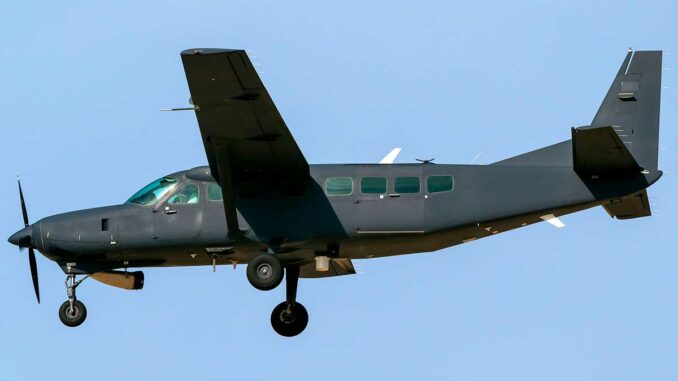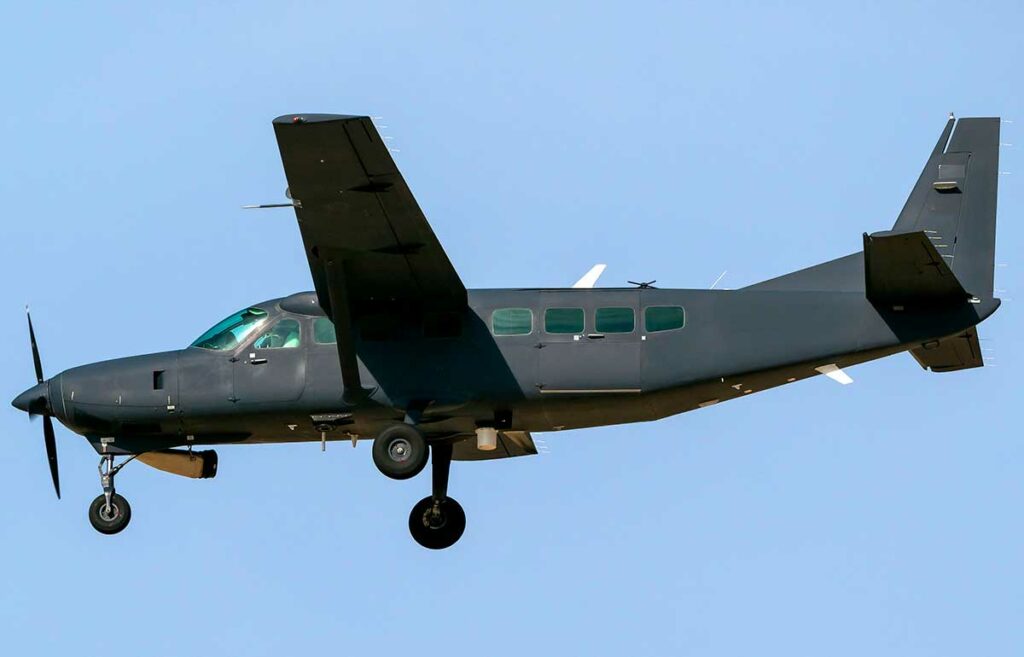
A $17.4 million contract equips a Cessna 208B with the Reliable Autonomy System to validate the safe integration of drones into civil and military airspace.
In summary
The US Air Force has awarded a $17.4 million (approximately €16.2 million) contract to purchase, integrate, and test the Reliable Autonomy System on a Cessna 208B. The operational objective is clear: to demonstrate certifiable autonomy that is compatible with FAA certification rules and transferable to other platforms. The program aims to prove that a light cargo aircraft can fly with remote piloting, take off, cruise, and land with minimal human supervision, while complying with detection and avoidance requirements. The Caravan was chosen for its widespread use, cost, and mission profile. Ultimately, the architecture could support tactical logistics, sensor relay, and forward base support missions. The prospective manufacturer, Reliable Robotics, is proposing a “continuous autopilot” approach from taxiing to landing, coupled with air-to-air radar for DAA. The project is part of AFWERX’s strategy for rapid maturation of critical technologies.
Program framework and capability logic
The notified contract covers the acquisition of a 208B, the integration of the autonomy system, and a several-month test campaign, with logistics-oriented demonstration flights. The scope aims to qualify autonomy on a certified and widely operated aircraft, which is essential to convince regulators and military leaders that large-scale UAS integration is feasible in the National Airspace System. Specialized publications and industry announcements mention a ramp-up of testing in 2026–2027, in line with the FAA testing and acceptance cycles already undertaken by the manufacturer.
The $17.4 million will finance not only the sensors, computers, and actuators, but also software qualification and the security of the command and control link. The budget remains modest on a DoD scale, but sufficient for a representative demonstrator. The choice of a high-wing aircraft with fixed landing gear, a maximum takeoff weight of approximately 3.99 tons, and a payload exceeding 1.3 tons ensures a margin for avionics and redundancies without impacting the mission profile. The business model then targets service or fleet conversion contracts, via certified retrofit kits.
The Reliable Autonomy System: architecture and key functions
The Reliable Autonomy System is presented as a “continuous autopilot”: the autopilot remains engaged from taxiing to parking. The architecture includes redundant computers, multiple sensor chains (GNSS/INS, altimetry, radios, vision/radar depending on configuration) and a detection and avoidance channel capable of providing “Remain Well Clear” and “Collision Avoidance” alerts against cooperative and non-cooperative traffic. The objective is to comply with FAA compliance requirements and prepare an STC applicable to existing airframes.
The DAA component is based on a dedicated air-to-air radar and fusion with transponder information. The anti-collision function is not enough: the aircraft must also anticipate conflicting trajectories, suggest maneuvers to the pilot remotely, or even execute them according to predefined rules. The company has reported on DAA test flights and a progressive qualification roadmap, combining simulation and actual flights to prove coverage of edge cases.

The Cessna 208B as a test bed: technical and operational reasons
The Cessna 208B is widespread, rugged, and forgiving, with upgradeable avionics and sufficient power margins. For unpressurized cargo missions, its moderate cruising speed and short takeoff distance are well suited to rugged terrain. For an autonomy program, the stability of the platform simplifies the validation of control laws, the integration of actuators on primary controls, and the recertification of critical systems. Recent tests have already demonstrated the feasibility of tele-operated flight from taxi to landing, an important milestone in the transition to a “tele-piloted supervision” mode rather than a “permanent man-in-the-loop” mode.
In terms of safety, continuous automation allows for the locking of protections: anti-stall, attitude limits, terrain avoidance, fuel management, and alternative routes in case of weather deterioration. The challenge is to prove operational safety at least equivalent to conventional piloting, with a level of software assurance (DO-178C) adapted to critical functions. The manufacturer says it is working with the FAA on the certification basis (G-1), means of compliance, and a specific certification plan, accepted since 2022–2023.
FAA certification and integration into civil airspace
Integration into airspace requires demonstration of safety equivalence. Three areas are key: certifiable autonomous flight control, DAA that complies with Remain Well Clear policies, and a secure, fault-tolerant command and control link. The FAA has accepted the basis and certification plan for the continuous autopilot, paving the way for airframe-specific STCs. Testing is continuing with DAA data collection flights at FAA and university partner sites. The approach is incremental: first cargo and simple routes, then increasingly complex air environments, until regular operations in controlled airspace.
Beyond the technical rules, the operator must comply with Part 135 (cargo) operational requirements and demonstrate supervision procedures: control center, risk assessment, contingency plan in case of loss of connection. The feedback expected from the 208B should support a deployment doctrine: how many aircraft per supervisor, what levels of autonomy per flight phase, and what transition to mixed profiles (autonomous then piloted segments, or vice versa).
Military use cases: agile logistics and sensor relays
For the DoD, the value lies in dispersed and repetitive logistics links: critical parts, blood, light ammunition, sensors. An autonomous light aircraft relieves human crews of medium-risk “milk runs,” freeing crews for complex missions. The autonomous 208B can operate from rudimentary runways, serve forward operating bases, and complete several daily rotations. Conceptual designs also include medium-altitude communications/ISR relay, with the aircraft flying predefined automatic patterns and maintaining a station with reduced consumption.
In contested environments, autonomy provides immediate reconfiguration capabilities: in-flight replanning, automatic diversion, weather/threat avoidance. Transposition to other airframes is a major focus: the manufacturer is promoting “airframe-agnostic” portability, opening the door to conversions to heavier or DoD-specific platforms. These prospects explain AFWERX’s involvement and the desire to validate the technology quickly in a real-world scenario.
Expected benefits: costs, safety, operational pace
The economic calculation is straightforward: fewer pilots on duty, more hours of use per aircraft, fewer flights canceled due to crew availability. At the same purchase cost, autonomy increases productivity per aircraft. Operational safety is a second lever: automation reduces recurring human errors (CFIT, loss of control, extreme workload). The argument presented by the manufacturer and echoed by the trade press emphasizes the “safety-first” objective: continuous autonomy must first prevent accidents before optimizing costs.
In the short term, the US Air Force is evaluating the technical availability, supervision procedures, and limitations of the DAA. In the medium term, the ambition is to obtain robust FAA certification opening up access to unescorted civil airspace, followed by ramp-up via conversion contracts for government or contracted cargo fleets. Public announcements explicitly refer to “civil and military” integration of the system, with an architecture designed to move from demonstrator to regular operations.
Technical risks and maturity barriers
Three challenges remain fundamental. First, detection and avoidance in all weather conditions: fog, rain, and multiple echoes degrade sensor performance. The radar/optical/transponder fusion must prove, with supporting statistics, its level of service in real conditions. Second, the cybersecurity of the link and the computer: encryption, mutual authentication, resilience to link losses. Finally, “fail-operational” qualification: continuing to fly safely despite the failure of a critical computer or sensor, which requires electrical, hydraulic, and software redundancy. The available documents and FAA statements show a phased approach, combining simulator tests and controlled flights.
The human factor should not be underestimated: remote piloting requires appropriate training and ergonomics, with synthetic displays and management of several aircraft by a supervisor. The size of the control centers will determine the real economic gain. The final decision-making authority (machine vs. supervisor) will need to be governed by clear rules, especially during rare events (uncooperative traffic, sensor failure combined with poor weather).
The industrial trajectory: from proof of concept to industrialization
Reliable Robotics has obtained FAA acceptance of the certification basis and plan, conducted teleoperated flights on Cessna 172 and then 208B aircraft, and initiated DAA testing with air-to-air radar. The agreement with the US Air Force lends credibility to the roadmap and accelerates development for military use cases. If the tests are conclusive, the next step will be an STC applicable to the 208B, followed by an extension to other airframes. The portability of the architecture is a key argument for securing expected conversion contracts, whether within the DoD, federal agencies, or regional cargo operators under Part 135.
Within a few years, the combination of low unit costs, gradual FAA certification, and feedback from real-world operations could shift light air logistics toward a mixed model: converted fleets for regular routes and piloted airframes retained for sensitive missions. The key will remain regulatory and social acceptability, which will depend on safety statistics and system transparency.
War Wings Daily is an independant magazine.